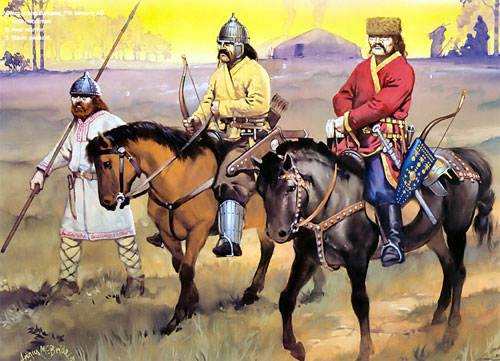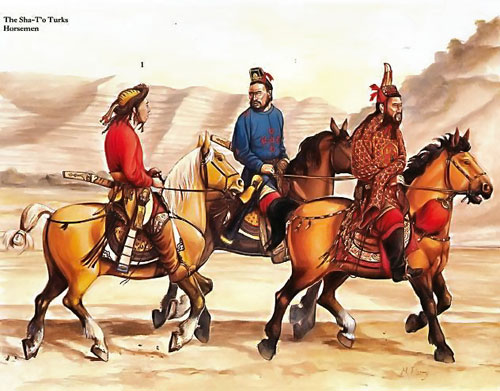Eurasian nomads, recognized for their ability to survive outside centralized civilizations, were able to survive the arid lands of Central Asia by adapting to their ecological surroundings. Unfortunately for them, Central Asia does not receive enough rain to support large-scale agriculture. As a result, with only miles of grasses and shrubs, these steppe lands lack large rivers or ponds of water that might support irrigation systems.
Their nomadic way of life depended on grazing animals that thrived on the grasslands and shrubs of these Central Asian steppes. They would take advantage of these grasslands to herd sheep, horses, cattle, goats, and camels. Nomadic people would drive their herds from one location to another in search of greener pastures. They were keenly aware of their migratory cycle. They took into account the seasons and the local climate, and they lived mostly off their animals: meat, milk, and the hides or fleece of their flocks. In fact, they used animal bones for tools and animal dung as fuel. Clothing and shoes would be made out of wool and skins. No matter what animal it was, there was always a use. Their hides, materials, and even alcoholic beverages all came from the herd of animals.1
Lacking a settled lifestyle, they developed a culture very different from urban societies. The climate was very harsh and with the lifestyle of the nomads, life was rough. As a result, they relied on opportunities to trade with settled people. Much of this trade was on a small scale due to the immediate needs of the nomadic people. However, because of their recognition of the land, they were able to create long-distance trade networks. The mobility and familiarity with large regions of Central Asia were skills that greatly benefited these nomads. These nomads organized and directed caravans across Central Asia linking the settled societies of China with those of the Mediterranean basin.2
Nomadic society was comprised of two social classes: the elites and commoners. Only the strong, charismatic leaders of the group would be recognized as elites. Once at that level, they would organize social clans and tribes. However, elites normally did little governing. The clans typically controlled their own affairs and resented any interference whatsoever. But when it was time for war, the elites took no remorse and put absolute authority over the forces within their alliances.3
Ultimately, this nomadic ‘nobility’ was a flexible social system. Leaders were able to pass elite status along to their heirs, as long as they acted appropriately. If not, they would be stripped from their position and cut short from any leadership role inside the clan. Meanwhile, commoners had the opportunity to become elites. If they exemplified good conduct by being courageous at warfare, they would have the opportunity to become an elite leader.4

As they expanded, nomadic people were able to create enormous military power due to their outstanding cavalry forces. They had superior equestrian skills, with deadly bow and arrow accuracy, capable of taking down anything that comes their way. They coordinated superb movements to outmaneuver their opponents. In fact, few armies were capable of resisting the mobility and discipline of well-organized nomadic warriors. With such military power, several groups of nomadic societies began to conquer the wealth of settled societies and build imperial states in the surrounding areas of Central Asia.5
No matter the setbacks, the Eurasian nomads were capable of surviving harsh conditions, limited water supply, and just about everything that came their way. At the end, they were able to establish successful trading opportunities with settled societies and gain valuable resources, while becoming one of the most feared and successful warriors in Central Asia due to their unmatched skills and mobility.
- Jerry Bentley, Herbert Ziegler, and Heather Streets Salter, Traditions & Encounters: A Brief Global History Volume 1, 4 edition (McGraw-Hill Education, 2015), 256. ↵
- Jerry Bentley, Herbert Ziegler, and Heather Streets Salter, Traditions & Encounters: A Brief Global History Volume 1, 4 edition (McGraw-Hill Education, 2015), 257. ↵
- Encyclopedia Britannica, June 2007, s.v. “The Steppe | Geographical area, Eurasia,” by William H. McNeill. ↵
- Encyclopedia Britannica, December 2015, s.v. “Turkic People,” by Lars Johanson. ↵
- Jerry Bentley, Herbert Ziegler, and Heather Streets Salter, Traditions & Encounters: A Brief Global History Volume 1, 4 edition (McGraw-Hill Education, 2015), 258. ↵



22 comments
Andrea Chavez
Your article is very interesting. I really did not know that nomadic people could gain such power. In my opinion you would settle to really set down the bases for a powerful tribe. So this is the first time I read about something like this. I also liked the “elite” way not being definite but variable depending on your attitude or character. But I really think your title really doesn’t go with the information you provide.
Clarissa Bustamante
I always that one big group traveling together was better than everyone being separated but now I understand as to why they didn’t, and why they traveled in groups. Also it is interesting how social classes existed in small groups as well such as the Nomads. the way you described the struggles the Nomads went through such as harsh climates and limited resources was great. I feel like you gave a great insight as to what they went through.
Andrew Rodriguez
The nomad people were survivors, and adjusted to any environment thrown into. While also having the ability to create societies, having a hierarchy in such a small tribe. sounds like they were setting up, a bunch of chiefdom society’s around where they went. They made the trade in a inconvenient location for many, they turned a liability into a asset. They came from just being survivors into building a permanent lifestyle for them to live off of and thrive on.
Alyssa Vela
This was very well written! I loved the amount of detail you put into your information. I don’t think I could’ve explained what the nomadic people went through any better than you did. I thought it was interesting how similar social classes were then, compared to now. You could have gone a little more into historical information but overall this was a great article. Very well written!
I look forward to reading more of your work in the near future.
Ana Gonzalez
Great job. I enjoyed reading your article and learning more about the Nomadic lifestyle. You did a good job explaining the hardships that nomadic people went through such as harsh climate and limited resources. It’s interesting to know that nomadic people relied on settled groups for trade but did not settle themselves and also that they had a great amount of military power. Thank you for the article!
Sam Vandenbrink
I thought it was interesting how they were able to have the most powerful army while not even having a home where they could build there army off of just a calvary. The social system of the clans was interesting as well. How the people pretty much governed themselves. When people govern themselves there seems to be allot less violence within individual units or group of people. Very informative article, enjoyed the read!
Cameron Mays
This article had a wide variety of content, which in itself is quite interesting, however, I feel as if the direction of the article wasn’t precisely conveyed. To elaborate, I feel as if there is so much to be said about each point that was brought up, that this article should have just focused on one of them, and expanded upon said point. You could have described in more detail how they made use of the land and animals, or how their social class worked and everybody’s job within the group, or you could have more elaborately described their war prowess instead of trying to cover everything in just a one page article. On the other hand, if it was written to summarize these people in general, the article was fantastic.
Andrew Ramon
It always amazes me to learn about how resource the people of the past were. Being able to use the resources given by an animal and using them for everyday life is astonishing. It is also very interesting how the nomadic lifestyle slowly transitioned into a social system. They even had working trade routes, that’s awesome! This article was very informative and well written, great job!
Erick Martinez
Great article, I am always amazed at how different nomadic life is from our urban societies today. These people focused on survival and survival only. I was unaware of how they thrived in all they did, and were very smart people, creating tools and learning seasons. They were well organized and loyal people who managed to survive tough conditions. It is inspiring to think of all they endured throughout their lives.
Priscilla Reyes
This article is great from beginning to end. I can only imagine the great difficulty of traveling with animals. It was interesting to find they used them for their alcoholic beverages, too. Also, it makes sense that they traded with others to obtain all that they needed, they couldn’t do everything themselves.
At first, it was difficult for me to understand the meaning behind what being an elite meant to the group, but just like in any society, they were the ones to decide upon issues and defend their people.
Its crazy how this system lead to important military leaders, despite their humble, nomad, beginnings. It makes sense, though because they had amazing leadership skills.
I love that you wrote about this topic and that you concluded with all their accomplishments which lead them to become successful warriors.